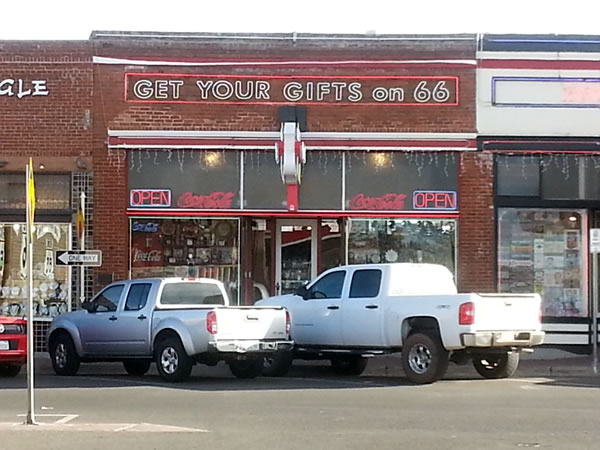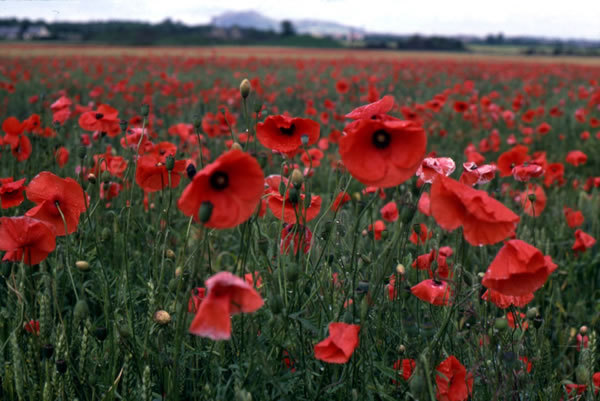Click the photo to see the ass-kicking at full size.
This photo op on Las Vegas Boulevard was the best five bucks I’ve spent all morning.
Once the scrap was over, we let bygones be bygones:
Click the photo to see it at full size.
A sampling of amusing things I photographed yesterday and while wandering around this morning looking for breakfast.
Oh, Route 66, you sold out, man. It used to be about the journey!

For a change of pace — and probably our only dinner away from The Strip — we had Indian at Mint last night. Very good.

“You know what would make this beer better? If there was some kind of insulating jacket for the can or bottle to keep it colder longer. And also: boobs.”

Despite being put on the permanent ineligibility list, “Charlie Hustle” seems to have done all right for himself. Just about every time I’ve ever been to Vegas, Pete Rose seems to have some afternoon autograph session where a long line of suckers — er, baseball fans — are all too happy to shell out ducats for his signature.

People pay to see this?

Probably no more authentic than anything else in Vegas, but I’d still buy a few things at both establishments…

By “cold beer”, they mean Bud, which in my books is a girly drink.

“See Santana live in his most intimate setting ever!” said the announcer, which led me to ask him “So Carlos is doing porn now?”
I’d also love to see Pennywise and Suicidal Tendencies play in that (relatively) small room too.

And I mean everything.
Is this your (ahem) first time in Vegas? Play this:

Dia de los Muertos was only last week, so this is still seasonally appropriate:

Given the number of older women who seem to dig the novels and movies, I’m surprised there was this but not a Twilight slot machine:

Triple chestburster bonus!

This wasn’t surprising at all:

It’s the slot machine Gotham needs!
Click the photo to see it at full size.
And finally, the most Vegas of all the slot machines:


A good follow-up is: “I didn’t do it. Nobody saw me do it. You can’t prove anything!“

The view from “the office”.
The nice thing about being able to work remotely is that I have been able to refer to some interesting places as “the office”. This week, it’s Sin City, where I’ll be all week.
I’m not paying the ripoff $15/day gym fees that hotels here insist on charging, so this week’s exercise will come from walking The Strip. If you have any recommendations or suggestions for destinations/things for me to photograph and post here, let me know in the comments!
Survivors walk on a road amidst heavy downpour after “super typhoon” Haiyan/Yolanda battered Tacloban city in central Philippines. (Source: International Business Times.)
The “super typhoon” known as “Haiyan” or “Yolanda” hit the central Philippines a few days ago, plowing into an estimated 25 million people, and killing an estimated 10,000. With sustained winds of up to 315 km/h (200 mph) — that’s 40 mph faster than the typical landing speed of a 737 — and gusts of up to 380 km/h (235 mph), the trail of devastation left by what is believed to be the strongest tropical storm in recorded history to make landfall is horrifying.
A man walks through the debris of smashed houses in Tacloban city, Leyte province, central Philippines. (Source: ABC News Australia.)
Philippine infrastructure isn’t what it should be at the best of times, and after a disaster like this one, it’s far, far worse. According to Nina Corpuz, a reporter with the Philippine TV channel ABS-CBN, only one hospital in the city of Tacloban, which was hit hard by the typhoon, is functioning, and it’s limited to 250 beds. With buildings reduced to rubble and roads destroyed, food, shelter, power, and medicine are in short supply.
Empty coffins lie on a street near houses damaged after “super typhoon” Haiyan/Yolanda battered Tacloban city. (Source: International Business Times.)
If you’d like to help with a donation, consider these guidelines from  Shai Coggins, my fellow blogger from the Philippines. She used these when trying to decide where to send her money:
Shai Coggins, my fellow blogger from the Philippines. She used these when trying to decide where to send her money:
1. I’d like my donation to go directly to the aid of the people affected by Typhoon Haiyan/Yolanda. That’s why I passed up on organisations whose “donate” button sent me to a general “international crisis” fund.
2. I want to donate to a local organisation who’s already doing the work in the affected areas. Reading news articles that pointed me to organisations who are already sending in people and aid made me look at their work more closely. This way, I can just support what they’ve started.
3. I need the donation process to be simple and straightforward, and one I can help to promote to others who might want to donate too. That’s why I liked donation pages that offer several options to send in the money – from Paypal and online credit cards to cheques and bank transfers.
This is how I ended up sending my support to the Philippine Red Cross at this time.
1000 Philippine pesos is a helpful amount to donate, and in U.S. and Canadian currency, that’s less than 25 bucks.
@SBTaskForce needs urgent help processing msgs for Typhoon #Yolanda – anyone can help! http://t.co/JKadmTNnlh #crisismapping @CrisisMappers
— Melissa Elliott (@MelyMello) November 10, 2013
If you have an internet connection and some time to spare, you can also help directly by participating in the “crisis mapping” effort. For more details, see here.
Sustained 315 km/h (200 mph) winds blew through Tacloban city, destroying houses and lifting cars. (Source: ABC News Australia.)
I’d like to send a big shout-out to the U.S. Marine Corps, who’ve responded to the Philippine government’s call for assistance. Thanks, guys!
U.S. Marines arrive in the Philippines at the request of the Philippine Government. (Source: TIME’s supertyphoon live blog.)
Filipinos are disproportionately big social media/smartphone/mobile phone users, so social media’s playing a big role in relief efforts and helping to find missing or displaced people. These hashtags may come in handy:
To stay on top of this news, TIME has a great live blog providing regularly updated coverage.

Poppies thrive in overturned soil, which is why they bloom in battlefields.
I’m in the United States as I write this, where November 11th — the anniversary of the end of World War I, also known as the Great War — is referred to as Veterans Day. In Canada and many other Commonwealth countries, November 11th is referred to as Remembrance Day.
Lt. Col. John Alexander McCrae, author of In Flanders Fields..
The symbol of Remembrance Day is the poppy, which grew in abundance in some of Europe’s bloodiest battlefields during World War I, and became the central image of In Flanders Fields, a poem written by Canadian soldier Lt. Col. John Alexander McCrae, a field surgeon assigned to the First Field Artillery Brigade after a particularly bloody battle in Ypres that started on April 22, 1915 and that lasted 17 days. After performing a funeral for his Alexis Helmer (no chaplain was available), McCrae sat in the back of an ambulance, from which wild poppies could be seen growing in a nearby cemetery, and wrote the following into his notebook:

Here’s the text of the poem:
In Flanders Fields the poppies blow,
Between the crosses row on row,
That mark our place; and in the sky
The larks, still bravely singing, fly
Scarce heard amid the guns below.We are the Dead. Short days ago
We lived, felt dawn, saw sunset glow,
Loved and were loved, and now we lie
In Flanders fields.Take up our quarrel with the foe:
To you from failing hands we throw
The torch; be yours to hold it high.
If ye break faith with us who die
We shall not sleep, though poppies grow
In Flanders fields.
He showed the poem to a Cyril Allinson, a 22 year-old sergeant-major, who was delivering mail at the time. Allinson is quoted as saying:
His face was very tired but calm as we wrote. He looked around from time to time, his eyes straying to Helmer’s grave.
The poem was exactly an exact description of the scene in front of us both. He used the word blow in that line because the poppies actually were being blown that morning by a gentle east wind.
It never occurred to me at that time that it would ever be published. It seemed to me just an exact description of the scene.
McCrae wasn’t satisfied with the poem and tossed it away. Luckily, a fellow officer retrieved it, and it was submitted to two British magazines: The Spectator and Punch. The Spectator rejected it, but fortunately for generations of soldiers, Punch saw fit to publish it in December 1915.
For our soldiers and the sacrifices they made, I’d like to say “thank you”.
Remember, that Facebook, while a handy world-spanning bulletin board, is no substitute for real life. Get out there, and don’t let Facebook turn your life into this…

Gary Smith tells me that this is a work by Polish illustrator Pawel Kuczynski, who’s done a lot of interesting satirical drawings in the same style.